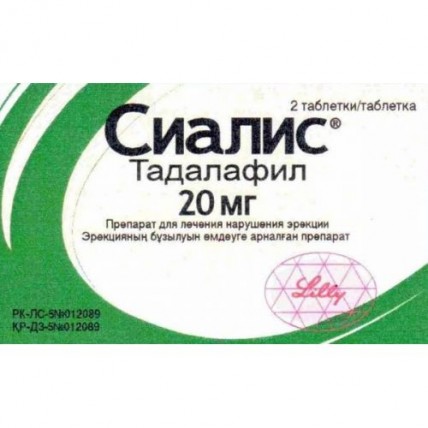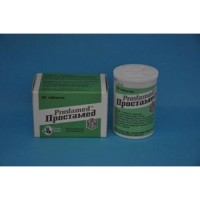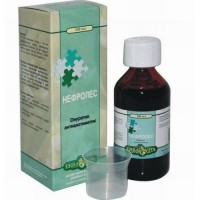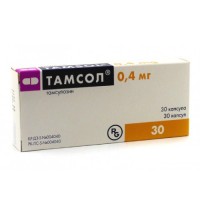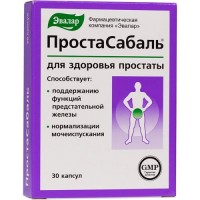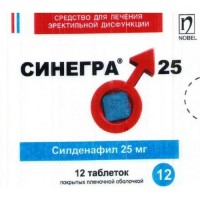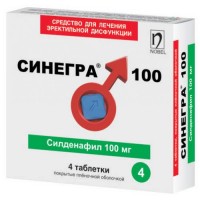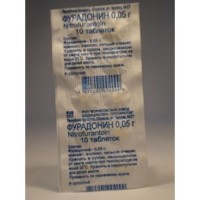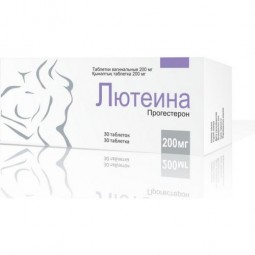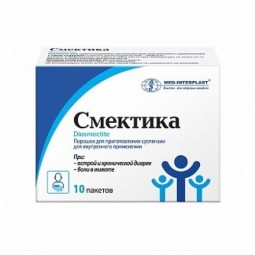Cialis (Tadalafil) 20 mg (4 coated tablets)
- $183.40
Cialis (Tadalafil) 20 mg 4 tabs is used to treat male sexual function problems (impotence or erectile dysfunction-ED). In combination with sexual stimulation, tadalafil works by increasing blood flow to the penis to help a man get and keep an erection.
One tablet contains the active substance - tadalafil 20 mg
- treatment of erectile dysfunction in adult male patients.
For the manifestation of the effect of tadalafil, sexual stimulation is necessary.
Cialis is not intended for use by women.
The usual recommended dose prior to anticipated sexual activity is 10 mg, with or without food. If taking 10 mg does not give the necessary reaction, then it is possible to increase the dose to 20 mg of tadalafil.
The drug should be taken at least 30 minutes before anticipated sexual activity.
The maximum recommended frequency of administration is once a day.
Tadalafil at a dose of 10 mg and 20 mg is intended to be taken before intended sexual activity and is not recommended for prolonged daily use.
For patients with the expected frequent intake of Cialis (i.e. at least twice a week), a suitable dosage regimen can be drawn up with a frequency of once a day in the lowest dose, in accordance with the patient's choice and the opinion of the attending physician.
For such patients, a dose of 5 mg is recommended once a day at about the same time.
A regular assessment of the appropriateness of long-term daily intake of the drug is necessary.
No dose adjustment is required for elderly patients.
Men with renal failure
No dose adjustment is required for patients with mild to moderate renal impairment. For patients with severe renal impairment, the maximum recommended dosage is 10 mg of the drug.
The once daily regimen of tadalafil is not recommended for patients with severe renal impairment.
The recommended dose of Cialis as needed is 10 mg before anticipated sexual activity, regardless of food intake. There are limited clinical data on the safety of the use of Cialis in patients with severe hepatic impairment (class C on the Child-Pugh scale). In the case of prescribing this drug, the attending physician should proceed from a careful individual assessment of the balance of benefits and risks. There is no data on taking tadalafil in doses exceeding 10 mg in patients with hepatic insufficiency.
The regimen of taking Cialis once a day has not been studied in patients with hepatic insufficiency, therefore, in the case of prescribing this drug, the attending physician should proceed from a careful individual assessment of the benefit and risk ratio.
No dosage adjustment is required for diabetic patients.
Cialis is not used to treat erectile dysfunction in children.
Adverse reactions that occurred more often than in isolated cases are listed according to the following gradation: very often (≥ 10%); often (≥ 1%, <10%); sometimes (≥ 0.1%, <1%); rarely (≥ 0.01%, <0.1%); extremely rare (<0.01%), the frequency is unknown (it is impossible to estimate the frequency of occurrence of reactions from the available data).
Often
- headache
- nasal congestion
- dyspepsia
- back pain, myalgia, pain in the limbs
- hyperemia
Sometimes
- hypersensitivity reactions
- dizziness
- blurred vision, pain in the eyeball
- ringing in the ears
- tachycardia, increased heart rate, hypotension3, hypertension
- shortness of breath, nosebleeds
- abdominal pain, vomiting, nausea, gastroesophageal reflux
- rash
- hematuria
- chest pain1, peripheral edema, fatigue
- long-term erection
Rarely
- Quincke's edema2
- stroke (including hemorrhagic stroke), syncope, transient ischemic attacks (TIA) 1, migraine2, convulsions2, transient amnesia
- narrowing of visual fields, eyelid edema, conjunctival hyperemia, anterior ischemic optic neuropathy not associated with arteritis2, retinal vascular occlusion2
- sudden hearing loss
- myocardial infarction, unstable angina pectoris3, ventricular arrhythmia2
- urticaria, Stevens-Johnson syndrome2, exfoliative dermatitis2, hyperhidrosis (sweating)
- priapism, bleeding from the penis, hematospermia
- facial edema2, sudden irreversible cardiac arrest3
1 Most patients were at risk of developing cardiovascular diseases.
2 Reactions observed during post-marketing surveillance were not observed in clinical trials conducted with placebo control.
3 Most often observed when tadalafil is prescribed to patients who are already taking antihypertensive drugs.
Description of selected adverse reactions
A slightly higher frequency of detecting changes on the ECG, primarily sinus bradycardia, is observed in patients who received tadalafil once a day compared with placebo. Most of these ECG abnormalities were not associated with adverse reactions.
There are limited data on the responses of patients over 65 years of age who received tadalafil for the treatment of erectile dysfunction or benign prostatic hyperplasia in clinical trials. In clinical trials in which patients with erectile dysfunction took tadalafil as needed, diarrhea was more common in patients over 65 years of age. In clinical trials, when taking 5 mg of tadalafil once a day for the treatment of benign prostatic hyperplasia, dizziness and diarrhea were noted with a greater frequency in patients over 75 years old.
Reporting Suspected Adverse Reactions
It is very important to submit reports of suspected adverse reactions after registration of a medicinal product. This allows you to constantly monitor the balance of benefits and risks of the drug. Healthcare professionals are asked to report any suspected adverse reactions.
- hypersensitivity to tadalafil or to any substance that is part of the drug
- taking medications containing any form of organic nitrates
- the presence of contraindications to sexual activity in patients with diseases of the cardiovascular system: myocardial infarction within the last 90 days, unstable angina pectoris or, the occurrence of an attack of angina pectoris during intercourse, heart failure class II or higher according to the classification of the New York Heart Association (NYHA ), detected within the last 6 months, uncontrolled heart rhythm disturbance, hypotension (with BP ˂90/50 mm Hg), or uncontrolled arterial hypertension, stroke within the last 6 months
- loss of vision in one eye due to non-arteritis-related anterior ischemic optic neuropathy (NAPION), regardless of whether it was associated with previous exposure to a PDE-5 inhibitor
- co-administration of PDE-5 inhibitors, including tadalafil, with guanylate cyclase stimulants such as riociguat, since it can potentially lead to the development of symptomatic hypotension
- do not apply to children and adolescents under 18 years of age
Effect of other substances on tadalafil
Cytochrome P450 inhibitors
Tadalafil metabolism occurs mainly under the action of the CYP3A4 enzyme. Taking ketoconazole (200 mg per day), a selective inhibitor of CYP3A4, doubles the plasma concentration (AUC) of tadalafil (10 mg) and Cmax by 15%, compared with the same values when taking tadalafil alone. Taking ketoconazole (400 mg per day) increases the plasma concentration of tadalafil (20 mg) by 4 times and Cmax by 22%. Ritonavir (200 mg twice daily), a protease inhibitor that inhibits CYP3A4, CYP2C9, CYP2C19 and CYP2D6, doubles the plasma concentration of tadalafil (20 mg) without changing Cmax. Although specific interactions have not been studied, other protease inhibitors such as saquinavir and other CYP3A4 inhibitors such as erythromycin, clarithromycin, itraconazole and grapefruit juice should be used with caution in conjunction with tadalafil, as an increase in plasma concentrations of tadalafil can be expected.
The role of carriers (for example, P-glycoprotein) in the pharmacokinetics of tadalafil has not been studied. Therefore, there is a possibility of drug interactions mediated by inhibition of vectors.
Cytochrome P450 inducers
The CYP3A4 inducer rifampicin reduces the plasma concentration of tadalafil by 88% compared to the plasma concentration of tadalafil (10 mg) when taken alone. A decrease in plasma concentration may lead to a decrease in the effectiveness of tadalafil, however, the severity of this decrease in effectiveness has not been studied. Other inducers of CYP3A4, such as phenobarbital, phenytoin, and carbamazepine, can also reduce plasma concentrations of tadalafil.
In the course of clinical studies, it was found that tadalafil (5, 10 and 20 mg) enhances the hypotensive effect of nitrates. Thus, taking Cialis is contraindicated in patients who take any form of organic nitrates. As a result of a clinical study in which 150 patients received tadalafil in a daily dose of 20 mg for 7 days and 0.4 mg of sublingual nitroglycerin at different times, it was found that the indicated interaction lasted more than 24 hours and was not detected after 48 hours after administration. the last dose of tadalafil. Thus, if in a patient taking Cialis in any dosage (2.5 mg - 20 mg), the use of nitrates is considered necessary in a life-threatening situation, at least 48 hours after taking the last dose of Cialis should pass before the decision to use nitrates. In such a situation, nitrates should be used only under strict medical supervision with adequate hemodynamic monitoring.
The joint administration of doxazosin (4 and 8 mg per day) and tadalafil (5 mg, taken regularly once a day and in a single dose of 20 mg) significantly enhances the hypotensive effect of this alpha-blocker. This effect lasts for at least twelve hours and can present with a variety of symptoms, including fainting. For this reason, the combination of these drugs is not recommended.
In a study of drug interactions conducted with the participation of a limited number of healthy volunteers, the effect described above was not observed when tadalafil was combined with alfuzosin or tamsulosin. However, caution should be exercised when using tadalafil in patients taking any alpha blockers, especially in the elderly. Treatment should be started with minimum dosages with gradual dose revision.
In clinical studies of drug interactions, the ability of tadalafil to enhance the hypotensive effect of antihypertensive drugs was studied. The main classes of antihypertensive drugs have been studied, including calcium channel blockers (amlodipine), angiotensin-converting enzyme (ACE) inhibitors (enalapril), beta-adrenergic receptor blockers (metoprolol), thiazide diuretics (bendrofluazide), and receptor blockers (various angiotensin types) and doses taken alone or in combination with thiazides, calcium channel blockers, beta-blockers and / or alpha-blockers). Tadalafil (10 mg, with the exception of interaction studies with angiotensin II receptor blockers and amlodipine, in which a dose of 20 mg was used) did not have a clinically significant interaction with drugs of any of these classes. Another clinical pharmacological study examined the interaction of tadalafil (20 mg) taken in combination with several (up to 4) classes of antihypertensive drugs. In patients taking multiple antihypertensive drugs, changes in blood pressure measured on an outpatient basis were correlated with measures to regulate pressure. In patients whose blood pressure was under careful drug regulation, its decrease was minimal, and similar to that in healthy study participants. In patients whose blood pressure was not regulated, its decrease was greater, although this decrease did not lead to the appearance of hypotensive symptoms in most of the observed. In patients receiving co-administered antihypertensive drugs, tadalafil 20 mg can cause a decrease in blood pressure, which (with the exception of alpha-blockers, see above) is usually minimal and most likely does not lead to clinically significant manifestations. Analysis of the third phase of clinical trials did not show any difference in the occurrence of side effects in patients taking tadalafil in parallel with taking antihypertensive drugs or in isolation. However, it is necessary to warn patients taking antihypertensive drugs about a possible decrease in arterial blood pressure.
Preclinical studies have shown an additional lowering effect on systemic blood pressure with the combined use of PDE-5 inhibitors and riociguat. In clinical studies, riociguat has shown an increase in the hypotensive effect of PDE-5 inhibitors. In the study groups of patients, there was no evidence of a beneficial clinical effect when such drugs were combined. The combined use of riociguat with PDE-5 inhibitors, including tadalafil, is contraindicated.
5-alpha reductase inhibitors
In clinical trials comparing the simultaneous use of 5 mg tadalafil and 5 mg finasteride with placebo and 5 mg finasteride in the symptomatic treatment of prostate adenoma, the onset of any new adverse reactions was not identified. However, since a formal study of drug interactions regarding the effects of the combined use of tadalafil and 5-alpha-reductase inhibitors has not been conducted, caution should be exercised when concomitant administration of tadalafil and 5-alpha-reductase inhibitors.
In a clinical study of drug interactions, the simultaneous use of 10 mg of tadalafil with theophylline (a non-selective phosphodiesterase inhibitor) did not show any pharmacokinetic interaction. The only pharmacodynamic effect was a slight (3.5 beats per minute) increase in heart rate. Although this effect is insignificant and was not clinically relevant in this study, it should be considered when these drugs are co-administered.
Ethinyl estradiol and terbutaline
Tadalafil has been shown to increase the bioavailability of ethinyl estradiol when taken orally; a similar increase can be expected with oral administration of terbutaline, although the clinical consequences of such an increase are uncertain.
Simultaneous administration of tadalafil (10 mg or 20 mg) does not increase the concentration of alcohol (the average maximum concentration in the blood is 0.08%). In addition, no changes in the concentration of tadalafil were observed 3 hours after coadministration with alcohol. Alcohol was administered in such a way as to maximize the rate of its absorption (after an overnight fast and without food for 2 hours after alcohol intake). Tadalafil (20 mg) did not increase the mean alcohol-induced decrease in blood pressure (0.7 g / kg, which is the same as taking 180 ml of 40% alcohol
by an 80 kg man), but postural dizziness and orthostatic hypotension were observed in a number of patients. When tadalafil was administered with lower doses of alcohol (0.6 g / kg), hypotension was not observed and dizziness was observed with the same frequency as with alcohol alone. The effect of alcohol on cognitive function was not altered with tadalafil (10 mg).
Tadalafil does not cause clinically significant inhibition or induction of drug clearance, metabolized by cytochrome P450 isoforms. Studies have confirmed that Tadalafil does not inhibit or induce cytochrome P450 isoforms, including CYP3A4, CYP1A2, CYP2D6, CYP2E1, CYP2C9 and CYP2C19.
CYP2C9 substrates (e.g. R-warfarin)
Tadalafil (10 mg and 20 mg) had no clinically significant effect on exposure (AUC) of S-warfarin or R-warfarin (a CYP2C9 substrate), and did not affect the changes in prothrombin time induced by warfarin.
Tadalafil (10 mg and 20 mg) does not increase the duration of bleeding caused by acetylsalicylic acid.
Antidiabetic medicines
Special studies of interactions with antidiabetic drugs have not been conducted.
Before starting treatment with Cialis
Before starting drug therapy, it is necessary to study the medical history and conduct a physical examination of the patient to diagnose erectile dysfunction and determine the potential causes of this condition.
Before starting any treatment for erectile dysfunction, it is necessary to assess the state of the patient's cardiovascular system, since there is a certain risk of complications from the cardiovascular system associated with sexual activity. Tadalafil has vasodilating properties, as a result of which it causes a mild and transient decrease in blood pressure and thus enhances the hypotensive effect of nitrates.
Erectile dysfunction assessment should include the identification of potential causes and appropriate treatments after proper medical evaluation. The effectiveness of Cialis in patients undergoing pelvic surgery or radical non-nerve-sparing prostatectomy has not been studied.
Cardiovascular diseases
Serious cardiovascular complications, including myocardial infarction, sudden irreversible cardiac arrest, unstable angina, ventricular arrhythmia, stroke, transient cerebrovascular accident, chest pain, palpitations, and tachycardia, have been reported in post-marketing surveillance and / or in the course of clinical trials. Most of the patients with these complications were at risk of developing cardiovascular diseases. However, it is not possible to establish with a high degree of certainty whether these events were directly associated with the risks of concomitant cardiovascular diseases, with the use of Cialis, with sexual activity, or a combination of these or other factors.
Taking Cialis while taking alpha-blockers1 can lead to symptomatic hypotension in some patients. The combination of tadalafil and doxazosin is not recommended.
Vision
Visual impairment and cases of anterior ischemic optic neuropathy not associated with arteritis have been reported in connection with the use of Cialis and other PDE-5 inhibitors. The patient should be aware that in case of sudden visual impairment, he should stop taking Cialis and immediately consult a doctor.
Hearing
Cases of sudden hearing loss have been reported after using Cialis. Although other risk factors are present in some cases (for example, age, diabetes mellitus, hypertension, and previous history of hearing loss), patients should be advised to stop taking Cialis and see a doctor in case of sudden hearing loss or loss.
Liver failure
There are limited clinical data on the safety of a single dose of Cialis in patients with severe hepatic impairment (class C on the Child-Pugh scale). In the case of prescribing Cialis, the attending physician should proceed from a careful individual assessment of the balance of benefits and risks.
Priapism and anatomical deformities of the penis
Patients should be informed of the need for immediate medical attention in case of an erection lasting 4 hours or more. Untimely treatment of priapism can lead to damage to the tissues of the penis and a permanent loss of potency.
Cialis should be used with caution in patients with anatomical deformity of the penis (for example, with angular curvature, cavernous fibrosis or Peyronie's disease) or in patients with a predisposition to priapism (for example, with sickle cell anemia, multiple myeloma or leukemia). inhibitors of CYP3A4
Caution should be exercised when prescribing Cialis to patients taking potent inhibitors of CYP3A4 (ritonavir, saquinavir, ketoconazole, itraconazole and erythromycin), since an increased concentration of tadalafil in the blood plasma was observed while taking these drugs.
The safety and efficacy of the combination of Cialis with other PDE-5 inhibitors and other methods of treating erectile dysfunction has not been studied. Patients should be informed about the inadmissibility of taking Cialis in such combinations.
Fertility
Two subsequent clinical trials showed that this effect is unlikely in humans, although a decrease in sperm concentration was noted in some men.
Cialis is not intended for use by women.
Lactose
Cialis contains lactose. Patients with rare hereditary galactose intolerance, Lapp lactase deficiency (congenital lactase deficiency), or glucose-galactose malabsorption should not take this drug.
Sodium content
This drug contains approximately 23 mg sodium per dose. Should be considered in patients on a controlled sodium diet.
Features of the effect of the drug on the ability to drive a vehicle or potentially dangerous mechanisms
Cialis has little effect on the ability to drive or operate machinery. Although the frequency of reports of dizziness when taking placebo and tadalafil in clinical trials was similar, patients should be aware of the peculiarities of their reaction to Cialis before starting to drive or operate machinery.
Healthy participants in clinical trials received a single dose of up to 500 mg and multiple daily doses of up to 100 mg. The adverse events were similar to those observed when taking tadalafil at lower doses.
In case of drug overdose, standard supportive measures should be taken if necessary. Hemodialysis practically does not accelerate the elimination of tadalafil.
1 or 2 tablets are placed in a blister strip made of polyvinyl chloride film (PVC / PE / PCTFE) and aluminum foil.
1 contour pack (for packs 1, 2) or 2 contour packs (for 4 packs) together with instructions for medical use
Structure
One tablet contains the active substance - tadalafil 20 mg
Indications for use
- treatment of erectile dysfunction in adult male patients.
For the manifestation of the effect of tadalafil, sexual stimulation is necessary.
Cialis is not intended for use by women.
Method of administration and dosage
Dosage
Adult men
The usual recommended dose prior to anticipated sexual activity is 10 mg, with or without food. If taking 10 mg does not give the necessary reaction, then it is possible to increase the dose to 20 mg of tadalafil.
The drug should be taken at least 30 minutes before anticipated sexual activity.
The maximum recommended frequency of administration is once a day.
Tadalafil at a dose of 10 mg and 20 mg is intended to be taken before intended sexual activity and is not recommended for prolonged daily use.
For patients with the expected frequent intake of Cialis (i.e. at least twice a week), a suitable dosage regimen can be drawn up with a frequency of once a day in the lowest dose, in accordance with the patient's choice and the opinion of the attending physician.
For such patients, a dose of 5 mg is recommended once a day at about the same time.
A regular assessment of the appropriateness of long-term daily intake of the drug is necessary.
Special categories of patients
Older men
No dose adjustment is required for elderly patients.
Men with renal failure
No dose adjustment is required for patients with mild to moderate renal impairment. For patients with severe renal impairment, the maximum recommended dosage is 10 mg of the drug.
The once daily regimen of tadalafil is not recommended for patients with severe renal impairment.
Men with liver failure
The recommended dose of Cialis as needed is 10 mg before anticipated sexual activity, regardless of food intake. There are limited clinical data on the safety of the use of Cialis in patients with severe hepatic impairment (class C on the Child-Pugh scale). In the case of prescribing this drug, the attending physician should proceed from a careful individual assessment of the balance of benefits and risks. There is no data on taking tadalafil in doses exceeding 10 mg in patients with hepatic insufficiency.
The regimen of taking Cialis once a day has not been studied in patients with hepatic insufficiency, therefore, in the case of prescribing this drug, the attending physician should proceed from a careful individual assessment of the benefit and risk ratio.
Men with diabetes
No dosage adjustment is required for diabetic patients.
Children
Cialis is not used to treat erectile dysfunction in children.
Side effects
Adverse reactions that occurred more often than in isolated cases are listed according to the following gradation: very often (≥ 10%); often (≥ 1%, <10%); sometimes (≥ 0.1%, <1%); rarely (≥ 0.01%, <0.1%); extremely rare (<0.01%), the frequency is unknown (it is impossible to estimate the frequency of occurrence of reactions from the available data).
Often
- headache
- nasal congestion
- dyspepsia
- back pain, myalgia, pain in the limbs
- hyperemia
Sometimes
- hypersensitivity reactions
- dizziness
- blurred vision, pain in the eyeball
- ringing in the ears
- tachycardia, increased heart rate, hypotension3, hypertension
- shortness of breath, nosebleeds
- abdominal pain, vomiting, nausea, gastroesophageal reflux
- rash
- hematuria
- chest pain1, peripheral edema, fatigue
- long-term erection
Rarely
- Quincke's edema2
- stroke (including hemorrhagic stroke), syncope, transient ischemic attacks (TIA) 1, migraine2, convulsions2, transient amnesia
- narrowing of visual fields, eyelid edema, conjunctival hyperemia, anterior ischemic optic neuropathy not associated with arteritis2, retinal vascular occlusion2
- sudden hearing loss
- myocardial infarction, unstable angina pectoris3, ventricular arrhythmia2
- urticaria, Stevens-Johnson syndrome2, exfoliative dermatitis2, hyperhidrosis (sweating)
- priapism, bleeding from the penis, hematospermia
- facial edema2, sudden irreversible cardiac arrest3
1 Most patients were at risk of developing cardiovascular diseases.
2 Reactions observed during post-marketing surveillance were not observed in clinical trials conducted with placebo control.
3 Most often observed when tadalafil is prescribed to patients who are already taking antihypertensive drugs.
Description of selected adverse reactions
A slightly higher frequency of detecting changes on the ECG, primarily sinus bradycardia, is observed in patients who received tadalafil once a day compared with placebo. Most of these ECG abnormalities were not associated with adverse reactions.
Other special categories of patients
There are limited data on the responses of patients over 65 years of age who received tadalafil for the treatment of erectile dysfunction or benign prostatic hyperplasia in clinical trials. In clinical trials in which patients with erectile dysfunction took tadalafil as needed, diarrhea was more common in patients over 65 years of age. In clinical trials, when taking 5 mg of tadalafil once a day for the treatment of benign prostatic hyperplasia, dizziness and diarrhea were noted with a greater frequency in patients over 75 years old.
Reporting Suspected Adverse Reactions
It is very important to submit reports of suspected adverse reactions after registration of a medicinal product. This allows you to constantly monitor the balance of benefits and risks of the drug. Healthcare professionals are asked to report any suspected adverse reactions.
Contraindications
- hypersensitivity to tadalafil or to any substance that is part of the drug
- taking medications containing any form of organic nitrates
- the presence of contraindications to sexual activity in patients with diseases of the cardiovascular system: myocardial infarction within the last 90 days, unstable angina pectoris or, the occurrence of an attack of angina pectoris during intercourse, heart failure class II or higher according to the classification of the New York Heart Association (NYHA ), detected within the last 6 months, uncontrolled heart rhythm disturbance, hypotension (with BP ˂90/50 mm Hg), or uncontrolled arterial hypertension, stroke within the last 6 months
- loss of vision in one eye due to non-arteritis-related anterior ischemic optic neuropathy (NAPION), regardless of whether it was associated with previous exposure to a PDE-5 inhibitor
- co-administration of PDE-5 inhibitors, including tadalafil, with guanylate cyclase stimulants such as riociguat, since it can potentially lead to the development of symptomatic hypotension
- do not apply to children and adolescents under 18 years of age
Drug interactions
Effect of other substances on tadalafil
Cytochrome P450 inhibitors
Tadalafil metabolism occurs mainly under the action of the CYP3A4 enzyme. Taking ketoconazole (200 mg per day), a selective inhibitor of CYP3A4, doubles the plasma concentration (AUC) of tadalafil (10 mg) and Cmax by 15%, compared with the same values when taking tadalafil alone. Taking ketoconazole (400 mg per day) increases the plasma concentration of tadalafil (20 mg) by 4 times and Cmax by 22%. Ritonavir (200 mg twice daily), a protease inhibitor that inhibits CYP3A4, CYP2C9, CYP2C19 and CYP2D6, doubles the plasma concentration of tadalafil (20 mg) without changing Cmax. Although specific interactions have not been studied, other protease inhibitors such as saquinavir and other CYP3A4 inhibitors such as erythromycin, clarithromycin, itraconazole and grapefruit juice should be used with caution in conjunction with tadalafil, as an increase in plasma concentrations of tadalafil can be expected.
Carriers
The role of carriers (for example, P-glycoprotein) in the pharmacokinetics of tadalafil has not been studied. Therefore, there is a possibility of drug interactions mediated by inhibition of vectors.
Cytochrome P450 inducers
The CYP3A4 inducer rifampicin reduces the plasma concentration of tadalafil by 88% compared to the plasma concentration of tadalafil (10 mg) when taken alone. A decrease in plasma concentration may lead to a decrease in the effectiveness of tadalafil, however, the severity of this decrease in effectiveness has not been studied. Other inducers of CYP3A4, such as phenobarbital, phenytoin, and carbamazepine, can also reduce plasma concentrations of tadalafil.
The effect of tadalafil on other medicines
Nitrates
In the course of clinical studies, it was found that tadalafil (5, 10 and 20 mg) enhances the hypotensive effect of nitrates. Thus, taking Cialis is contraindicated in patients who take any form of organic nitrates. As a result of a clinical study in which 150 patients received tadalafil in a daily dose of 20 mg for 7 days and 0.4 mg of sublingual nitroglycerin at different times, it was found that the indicated interaction lasted more than 24 hours and was not detected after 48 hours after administration. the last dose of tadalafil. Thus, if in a patient taking Cialis in any dosage (2.5 mg - 20 mg), the use of nitrates is considered necessary in a life-threatening situation, at least 48 hours after taking the last dose of Cialis should pass before the decision to use nitrates. In such a situation, nitrates should be used only under strict medical supervision with adequate hemodynamic monitoring.
Antihypertensives (including calcium channel blockers)
The joint administration of doxazosin (4 and 8 mg per day) and tadalafil (5 mg, taken regularly once a day and in a single dose of 20 mg) significantly enhances the hypotensive effect of this alpha-blocker. This effect lasts for at least twelve hours and can present with a variety of symptoms, including fainting. For this reason, the combination of these drugs is not recommended.
In a study of drug interactions conducted with the participation of a limited number of healthy volunteers, the effect described above was not observed when tadalafil was combined with alfuzosin or tamsulosin. However, caution should be exercised when using tadalafil in patients taking any alpha blockers, especially in the elderly. Treatment should be started with minimum dosages with gradual dose revision.
In clinical studies of drug interactions, the ability of tadalafil to enhance the hypotensive effect of antihypertensive drugs was studied. The main classes of antihypertensive drugs have been studied, including calcium channel blockers (amlodipine), angiotensin-converting enzyme (ACE) inhibitors (enalapril), beta-adrenergic receptor blockers (metoprolol), thiazide diuretics (bendrofluazide), and receptor blockers (various angiotensin types) and doses taken alone or in combination with thiazides, calcium channel blockers, beta-blockers and / or alpha-blockers). Tadalafil (10 mg, with the exception of interaction studies with angiotensin II receptor blockers and amlodipine, in which a dose of 20 mg was used) did not have a clinically significant interaction with drugs of any of these classes. Another clinical pharmacological study examined the interaction of tadalafil (20 mg) taken in combination with several (up to 4) classes of antihypertensive drugs. In patients taking multiple antihypertensive drugs, changes in blood pressure measured on an outpatient basis were correlated with measures to regulate pressure. In patients whose blood pressure was under careful drug regulation, its decrease was minimal, and similar to that in healthy study participants. In patients whose blood pressure was not regulated, its decrease was greater, although this decrease did not lead to the appearance of hypotensive symptoms in most of the observed. In patients receiving co-administered antihypertensive drugs, tadalafil 20 mg can cause a decrease in blood pressure, which (with the exception of alpha-blockers, see above) is usually minimal and most likely does not lead to clinically significant manifestations. Analysis of the third phase of clinical trials did not show any difference in the occurrence of side effects in patients taking tadalafil in parallel with taking antihypertensive drugs or in isolation. However, it is necessary to warn patients taking antihypertensive drugs about a possible decrease in arterial blood pressure.
Riociguat
Preclinical studies have shown an additional lowering effect on systemic blood pressure with the combined use of PDE-5 inhibitors and riociguat. In clinical studies, riociguat has shown an increase in the hypotensive effect of PDE-5 inhibitors. In the study groups of patients, there was no evidence of a beneficial clinical effect when such drugs were combined. The combined use of riociguat with PDE-5 inhibitors, including tadalafil, is contraindicated.
5-alpha reductase inhibitors
In clinical trials comparing the simultaneous use of 5 mg tadalafil and 5 mg finasteride with placebo and 5 mg finasteride in the symptomatic treatment of prostate adenoma, the onset of any new adverse reactions was not identified. However, since a formal study of drug interactions regarding the effects of the combined use of tadalafil and 5-alpha-reductase inhibitors has not been conducted, caution should be exercised when concomitant administration of tadalafil and 5-alpha-reductase inhibitors.
CYP1A2 substrates (eg, theophylline)
In a clinical study of drug interactions, the simultaneous use of 10 mg of tadalafil with theophylline (a non-selective phosphodiesterase inhibitor) did not show any pharmacokinetic interaction. The only pharmacodynamic effect was a slight (3.5 beats per minute) increase in heart rate. Although this effect is insignificant and was not clinically relevant in this study, it should be considered when these drugs are co-administered.
Ethinyl estradiol and terbutaline
Tadalafil has been shown to increase the bioavailability of ethinyl estradiol when taken orally; a similar increase can be expected with oral administration of terbutaline, although the clinical consequences of such an increase are uncertain.
Alcohol
Simultaneous administration of tadalafil (10 mg or 20 mg) does not increase the concentration of alcohol (the average maximum concentration in the blood is 0.08%). In addition, no changes in the concentration of tadalafil were observed 3 hours after coadministration with alcohol. Alcohol was administered in such a way as to maximize the rate of its absorption (after an overnight fast and without food for 2 hours after alcohol intake). Tadalafil (20 mg) did not increase the mean alcohol-induced decrease in blood pressure (0.7 g / kg, which is the same as taking 180 ml of 40% alcohol
by an 80 kg man), but postural dizziness and orthostatic hypotension were observed in a number of patients. When tadalafil was administered with lower doses of alcohol (0.6 g / kg), hypotension was not observed and dizziness was observed with the same frequency as with alcohol alone. The effect of alcohol on cognitive function was not altered with tadalafil (10 mg).
Drugs metabolized by cytochrome P450 enzymes
Tadalafil does not cause clinically significant inhibition or induction of drug clearance, metabolized by cytochrome P450 isoforms. Studies have confirmed that Tadalafil does not inhibit or induce cytochrome P450 isoforms, including CYP3A4, CYP1A2, CYP2D6, CYP2E1, CYP2C9 and CYP2C19.
CYP2C9 substrates (e.g. R-warfarin)
Tadalafil (10 mg and 20 mg) had no clinically significant effect on exposure (AUC) of S-warfarin or R-warfarin (a CYP2C9 substrate), and did not affect the changes in prothrombin time induced by warfarin.
Aspirin
Tadalafil (10 mg and 20 mg) does not increase the duration of bleeding caused by acetylsalicylic acid.
Antidiabetic medicines
Special studies of interactions with antidiabetic drugs have not been conducted.
Special instructions
Before starting treatment with Cialis
Before starting drug therapy, it is necessary to study the medical history and conduct a physical examination of the patient to diagnose erectile dysfunction and determine the potential causes of this condition.
Before starting any treatment for erectile dysfunction, it is necessary to assess the state of the patient's cardiovascular system, since there is a certain risk of complications from the cardiovascular system associated with sexual activity. Tadalafil has vasodilating properties, as a result of which it causes a mild and transient decrease in blood pressure and thus enhances the hypotensive effect of nitrates.
Erectile dysfunction assessment should include the identification of potential causes and appropriate treatments after proper medical evaluation. The effectiveness of Cialis in patients undergoing pelvic surgery or radical non-nerve-sparing prostatectomy has not been studied.
Cardiovascular diseases
Serious cardiovascular complications, including myocardial infarction, sudden irreversible cardiac arrest, unstable angina, ventricular arrhythmia, stroke, transient cerebrovascular accident, chest pain, palpitations, and tachycardia, have been reported in post-marketing surveillance and / or in the course of clinical trials. Most of the patients with these complications were at risk of developing cardiovascular diseases. However, it is not possible to establish with a high degree of certainty whether these events were directly associated with the risks of concomitant cardiovascular diseases, with the use of Cialis, with sexual activity, or a combination of these or other factors.
Taking Cialis while taking alpha-blockers1 can lead to symptomatic hypotension in some patients. The combination of tadalafil and doxazosin is not recommended.
Vision
Visual impairment and cases of anterior ischemic optic neuropathy not associated with arteritis have been reported in connection with the use of Cialis and other PDE-5 inhibitors. The patient should be aware that in case of sudden visual impairment, he should stop taking Cialis and immediately consult a doctor.
Hearing
Cases of sudden hearing loss have been reported after using Cialis. Although other risk factors are present in some cases (for example, age, diabetes mellitus, hypertension, and previous history of hearing loss), patients should be advised to stop taking Cialis and see a doctor in case of sudden hearing loss or loss.
Liver failure
There are limited clinical data on the safety of a single dose of Cialis in patients with severe hepatic impairment (class C on the Child-Pugh scale). In the case of prescribing Cialis, the attending physician should proceed from a careful individual assessment of the balance of benefits and risks.
Priapism and anatomical deformities of the penis
Patients should be informed of the need for immediate medical attention in case of an erection lasting 4 hours or more. Untimely treatment of priapism can lead to damage to the tissues of the penis and a permanent loss of potency.
Cialis should be used with caution in patients with anatomical deformity of the penis (for example, with angular curvature, cavernous fibrosis or Peyronie's disease) or in patients with a predisposition to priapism (for example, with sickle cell anemia, multiple myeloma or leukemia). inhibitors of CYP3A4
Caution should be exercised when prescribing Cialis to patients taking potent inhibitors of CYP3A4 (ritonavir, saquinavir, ketoconazole, itraconazole and erythromycin), since an increased concentration of tadalafil in the blood plasma was observed while taking these drugs.
Combination of Cialis and other erectile dysfunction treatments
The safety and efficacy of the combination of Cialis with other PDE-5 inhibitors and other methods of treating erectile dysfunction has not been studied. Patients should be informed about the inadmissibility of taking Cialis in such combinations.
Fertility
Two subsequent clinical trials showed that this effect is unlikely in humans, although a decrease in sperm concentration was noted in some men.
Cialis is not intended for use by women.
Lactose
Cialis contains lactose. Patients with rare hereditary galactose intolerance, Lapp lactase deficiency (congenital lactase deficiency), or glucose-galactose malabsorption should not take this drug.
Sodium content
This drug contains approximately 23 mg sodium per dose. Should be considered in patients on a controlled sodium diet.
Features of the effect of the drug on the ability to drive a vehicle or potentially dangerous mechanisms
Cialis has little effect on the ability to drive or operate machinery. Although the frequency of reports of dizziness when taking placebo and tadalafil in clinical trials was similar, patients should be aware of the peculiarities of their reaction to Cialis before starting to drive or operate machinery.
Overdose
Healthy participants in clinical trials received a single dose of up to 500 mg and multiple daily doses of up to 100 mg. The adverse events were similar to those observed when taking tadalafil at lower doses.
In case of drug overdose, standard supportive measures should be taken if necessary. Hemodialysis practically does not accelerate the elimination of tadalafil.
Release form and packaging
1 or 2 tablets are placed in a blister strip made of polyvinyl chloride film (PVC / PE / PCTFE) and aluminum foil.
1 contour pack (for packs 1, 2) or 2 contour packs (for 4 packs) together with instructions for medical use
